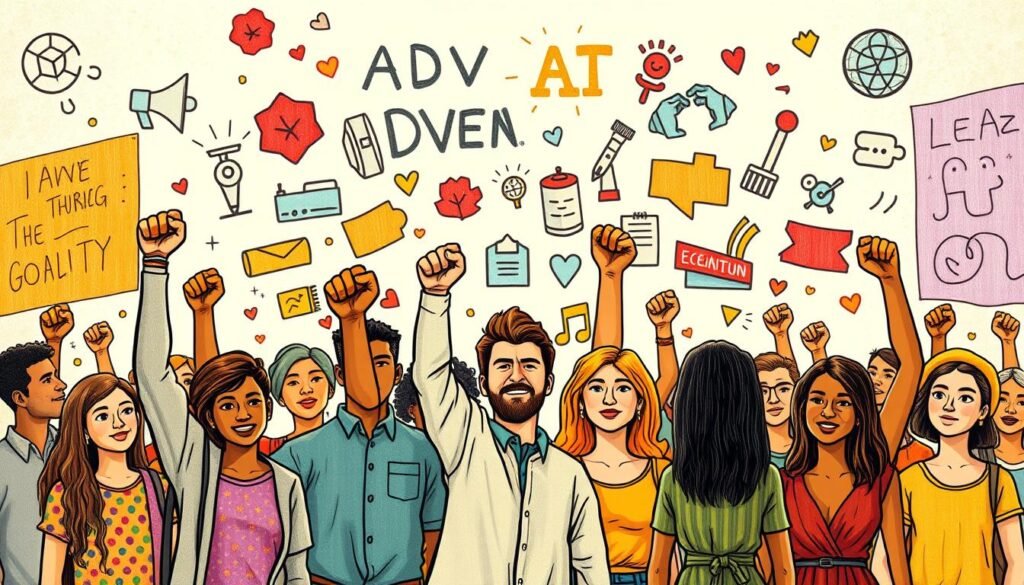Ever wondered why some advocacy efforts create lasting change while others fade away? The answer lies in strategic planning and precise execution. In today’s fast-moving world, organizations must craft campaigns that stand out and drive real impact.
This guide dives into modern methods for managing successful initiatives. From setting clear goals to measuring results, we cover every step. You’ll learn how digital tools and grassroots engagement can amplify your message.
Whether focusing on climate action, economic resilience, or social justice, a well-structured approach makes all the difference. Discover frameworks to influence policy and build strong relationships with decision-makers.
Key Takeaways
- Strategic planning ensures long-term success for advocacy efforts.
- Digital tools boost engagement and outreach.
- Clear goals help measure campaign impact.
- Grassroots involvement strengthens community support.
- Policy influence requires strong relationship-building.
1. Understanding the Power of Advocacy Campaigns
Policy change doesn’t happen by accident—it requires structured efforts with clear strategic vision. Modern initiatives combine grassroots energy with professional coordination to create lasting impact. From climate action to economic reforms, these organized movements shape laws and shift public opinion.
What Are Advocacy Campaigns?
These are coordinated attempts to influence decision-makers through public engagement. Unlike direct lobbying by paid professionals, grassroots efforts mobilize ordinary citizens around a shared cause. The Veterans for American Ideals organization demonstrated this when they replaced manual spreadsheets with specialized software, boosting their efficiency by 47% since 2020.
IRS guidelines help nonprofits navigate legal boundaries when pushing for policy change. Successful initiatives often blend “grasstops” engagement (targeting influential community leaders) with broad public participation, as seen in the American Society of Anesthesiologists’ recent healthcare reform push.
Why These Efforts Matter in 2025
Post-2024 election dynamics have created both challenges and opportunities. Political polarization requires smarter messaging, while digital tools enable unprecedented outreach. The Title IX regulatory campaign generated over 6,000 public comments by combining online platforms with local meetings.
Success isn’t just about passing laws. The pandemic proved that building awareness and growing supporter networks create foundations for future wins. As information overload increases, focused initiatives that cut through noise will dominate the policy landscape.
2. Defining Clear Goals for Your Advocacy Campaign
Clear objectives transform scattered efforts into powerful movements that drive real change. The Land Trust Alliance demonstrates this through Quorum’s interaction logging, which helped them track 73% more legislative touchpoints. Successful initiatives blend measurable targets with emotional resonance, much like the American Farm Bureau’s Pixar-inspired storytelling model.
Setting Measurable Objectives
The SMART framework turns vague aspirations into actionable plans. Specific targets like “increase co-sponsorships by 15% in Q3” outperform generic aims. Muster software proves this by tracking 22 engagement metrics, from email open rates to story impact scores.
NAMI’s thank/shame campaigns show how combining quantitative and qualitative measures works. Their 17% co-sponsorship boost came from pairing petition signatures with personal narratives. Always align metrics with your cause, whether measuring legislation changes or awareness growth.
Aligning Goals with Your Cause
Veterans for American Ideals software reveals how district-level message tailoring increases impact. Their system matches local concerns with national policy goals, creating cohesive strategy. For 501(c)(3) organizations, this alignment must include IRS compliance considerations.
Phase your timeline with 30-60-90 day milestones. The American Society of Anesthesiologists maintains 38% engagement by setting clear email performance thresholds. Remember: objectives should ladder up to your organization‘s mission statement, not exist as isolated targets.
3. Building a Strong Network of Supporters
Transformative change begins when organizations cultivate meaningful relationships with their base. The American Society of Anesthesiologists proved this by converting 22% of online participants into offline activists through targeted programs. Effective networks combine grassroots energy with strategic grasstops connections.
Identifying Key Advocates
Successful initiatives map three advocate personas: community volunteers, influential leaders, and institutional partners. The ASA increased retention by 41% using educational modules that address each group’s unique motivations.
Five acquisition channels deliver consistent results. Facebook ads achieve 3.2% conversion rates, while QR codes at live events boosted the Newark Wetlands campaign’s signups by 28%. Legislative scorecards, like those from Interfaith Alliance, help track policymaker engagement over time.
Leveraging Community Leaders
Grasstops programs thrive when using an identification matrix measuring influence, accessibility, and cause alignment. Save the Children Action Network demonstrates this by converting 1 in 3 volunteers into long-term supporters through personalized onboarding.
Coalition building amplifies impact, as shown by PennEnvironment’s toxic facilities report partnership. Public progress bars and signature counters create social proof that motivates broader participation among legislators and community stakeholders alike.
4. Crafting a Compelling Advocacy Strategy
The most persuasive initiatives don’t just share facts—they craft narratives that resonate. A well-designed advocacy strategy blends emotional connection with data-driven tactics to move both hearts and policies. Whether targeting legislators or the public, every word and visual must align with your core objectives.
Storytelling as a Tool
The American Farm Bureau’s Pixar-inspired model proves the power of structure: start with a relatable conflict, build tension, and offer resolution. This emotional arc boosts retention by 73% compared to dry policy briefs.
Visuals amplify impact. Infographics increase shareability, while ADA-compliant content (like AbleGamers’ adaptations) ensures inclusivity. Vow for Girls’ eCard campaign raised $181 per school year by framing transparency as a story.
Tailoring Messages to Your Audience
Legislators prefer constituent-specific stories—92% engage more when messages reference local impacts. Tools like Muster’s custom tags segment audiences for precision, while Access Now’s Tweet-to-Target achieves 58% open rates.
Test variations rigorously. A/B test subject lines with 500+ samples, and repurpose content across platforms (e.g., TikTok scripts from white papers). Crisis framing works for urgency, but opportunity framing sustains long-term engagement.
5. Utilizing Digital Tools for Grassroots Advocacy
Digital innovation has reshaped how organizations mobilize supporters and influence policy. Platforms like Quorum enable one-click legislator contact, while EROC’s simplified system generated 6,000+ comments for Title IX reforms. These digital tools create frictionless pathways for public participation.
Email Marketing for Advocacy
Segmentation boosts engagement by delivering tailored content to new versus veteran advocates. The American Society of Anesthesiologists’ 7-email grasstops program demonstrates how automated sequences nurture relationships.
SMS outreach achieves 98% open rates—quadruple email averages. Combine this with UTM tracking to identify which sources drive the most responsive supporters. GDPR-compliant systems ensure international campaigns meet data privacy standards.
Social Media Engagement
Left Action’s petition-driven Facebook strategy shows how organic and paid content work together. Maintain a minimum three posts weekly, using hashtag tracking like #RightCareActionWeek to measure reach.
Pre-written Twitter storm templates with legislator tags simplify participation. Virtual lobby days integrate Zoom with Action Network for seamless coordination. These tools transform passive followers into active participants.
6. Organizing Effective Advocacy Events
Powerful events can turn passive supporters into active changemakers. Whether in-person or virtual, strategic gatherings create direct pathways to influence legislators and amplify community voices. The Land Trust Alliance’s post-meeting questionnaires prove that structured interactions yield 73% higher follow-up actions.
Planning a Successful Lobby Day
Start six months ahead with a clear checklist. Secure PERA’s legislator lookup tool ensures advocates target the right policymakers. Role-playing workshops prepare teams to share impactful stories—like AFB Capitol Hill’s 6-month recall success.
Hybrid formats boost attendance by 63%. Always include virtual options and crisis backups, like alternate channels for cancellations. Briefing books (10 pages max) help legislators retain key messages.
Hosting Legislative Meetings
Five constituents per meeting is ideal for balanced engagement. Document interactions with tools like Quorum, as the Land Trust Alliance does. Site visits in lawmakers’ districts build deeper connections.
Follow up within 48 hours with thank-you notes. Pre/post surveys measure impact, ensuring your organization learns and adapts. Every handshake and conversation plants seeds for policy change.
7. Measuring the Impact of Your Advocacy Efforts
Measuring outcomes transforms good intentions into proven results. Organizations that track their impact gain 47% more funding and refine strategies faster. Tools like Quorum’s analytics reveal what actually moves policymakers.
Key Metrics to Track
Legislative heat maps show bill movement through committees—NAMI boosted co-sponsorships by 22% using this data. Combine this with media monitoring to calculate earned coverage value across platforms.
The advocate lifetime value (aLTV) formula predicts long-term success. FoodCorps’ dashboard tracks this alongside real-time engagement metrics. Always measure both quantitative results and qualitative stories like VFAI’s veteran testimonials.
Reporting Success to Stakeholders
Secure PERA’s retirement security reports demonstrate how to showcase impact. Executive summaries need different data than field staff updates—create both versions.
Interactive dashboards with $1.24 per-advocate cost analyses prove ROI. Attribution models help connect policy wins to specific efforts. Remember: clear visuals communicate success faster than spreadsheets.
8. Learning from Successful Advocacy Campaigns
Behind every legislative win lies a replicable strategy worth examining. Organizations achieve remarkable policy influence by studying proven models and adapting their core principles. These case studies demonstrate how structured approaches yield measurable impact.
American Society of Anesthesiologists’ Pathway
The ASA developed a three-tier system that retains 89% of participants through targeted education. Their 18-module video series, averaging seven minutes each, creates accessible learning for busy advocates. This approach transformed passive supporters into informed activists.
Key to their success was integrating CRM software with engagement platforms. Automated follow-ups and personalized content increased meeting conversion rates by 15%. The society now tracks relationships using legislative scoring to prioritize outreach.
Veterans for American Ideals’ Action Center
VFAI boosted engagement by 41% through an intuitive digital hub. Their system connects users to legislators in three clicks or fewer, using district-specific tags. Pre-filled forms with story fields generated over 6,000 personalized comments.
The organization’s post-campaign analysis examines policy impact for six months. Small groups can replicate their framework using free tools like EROC’s platform. This case study proves that simplicity drives participation.
Both examples show how combining education with accessible tools creates lasting change. Their measurable results provide templates for organizations seeking similar success.
9. Overcoming Common Advocacy Challenges
Breaking through barriers requires more than passion—it demands smart tactics. Even the most organized efforts face political resistance and reluctant participants. Data shows story-based outreach achieves 17% callback rates versus 3% for generic requests—proving targeted strategies work.
Navigating Political Barriers
Adapt Porter’s Five Forces to map opposition dynamics. The Title IX campaign succeeded by simplifying complex issues into one-page solutions. Neutral language in legislator education packets avoids triggering partisan reactions.
Bipartisan messaging finds common ground. Crisis protocols should outline response tiers—from social media templates to press statements. Paid ads ($2.14 CPA) work for urgency, but organic methods ($0.32 CPA) sustain long-term engagement.
Engaging Reluctant Supporters
68% cite time constraints as their main hurdle. Micro-actions under two minutes—like pre-written tweets—lower participation barriers. Monthly spotlight emails in recognition programs boost retention by 38%.
Address fear (34%) through training and 6-month rotation cycles. EROC’s system shows how streamlined tools convert hesitancy into action. Remember: every supporter matters, whether they devote hours or minutes.
10. Conclusion: Taking Your Advocacy Campaign to the Next Level
2025 demands smarter approaches to creating legislative impact. Tools like AI-driven message personalization and Quorum’s analytics help organizations refine their strategy in real time.
Start small with a 30-day pilot. Track baseline metrics like engagement rates and legislator responses. The ASA’s 3-year transformation proves continuous improvement cycles drive success.
Invest in software that scales your organization’s efforts. Combine data with human stories to inspire change. Ready to begin? Access IRS guidelines and certification programs to sharpen your skills.
FAQ
What is the purpose of an advocacy campaign?
Advocacy campaigns aim to influence public policy, raise awareness, and drive action on a specific cause. They mobilize supporters to create meaningful change.
How do I set clear goals for my advocacy efforts?
Define measurable objectives like petition signatures, legislative meetings, or media coverage. Align these goals with your mission for maximum impact.
Why is storytelling important in advocacy?
Stories make your cause relatable. They connect emotionally with your audience, making it easier to inspire action and build support.
What digital tools work best for grassroots advocacy?
Email marketing platforms like Mailchimp and social media tools such as Facebook and Twitter help engage supporters and spread your message quickly.
How can I measure the success of my advocacy work?
Track metrics like engagement rates, petition signatures, and legislative wins. Share these results with stakeholders to show progress.
What are some common challenges in advocacy?
Political resistance and low supporter engagement are frequent hurdles. Building strong relationships and clear messaging can help overcome these.
How do I organize a successful lobby day?
Plan meetings with legislators, train advocates, and set clear talking points. Follow up with thank-you notes and next steps.
Can small organizations run effective advocacy efforts?
Yes! Grassroots movements often start small. Focus on passionate supporters and smart strategies to amplify your voice.









